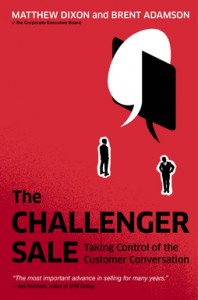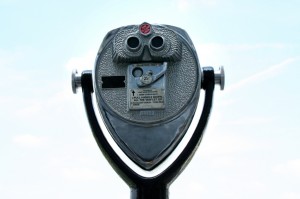 This book, by Brent Adamson and Matthew Dixon, comes very highly touted, especially by Neil Rackham himself, who calls it “the most important advance in selling for many years.”I’d restrain my enthusiasm a little short of that description, but overall it is an excellent book, with provocative insights and useful information for salespeople looking for ways to break out of the pack, especially in difficult economic times.
This book, by Brent Adamson and Matthew Dixon, comes very highly touted, especially by Neil Rackham himself, who calls it “the most important advance in selling for many years.”I’d restrain my enthusiasm a little short of that description, but overall it is an excellent book, with provocative insights and useful information for salespeople looking for ways to break out of the pack, especially in difficult economic times.
The key to a really good book is that it makes you say, “I never thought of that before,” and to use that insight to improve your life in some way. Interestingly, that’s also the key to a really good salesperson, as well.
As part of the research for my book on executive sales presentations, I have spent the past two weeks interviewing senior executives in order to get an understanding from them about what they see when they are on the receiving end of sales presentations. Although I haven’t completed all of the scheduled interviews yet, some very clear insights have emerged. I have bad news, worse news, and ultimately some good news.
First, the bad news: I asked each executive how they would rank the general quality of the sales presentations they see, and the average is between 5 and 6 on a ten point scale, with a very wide variance within individual estimations. In other words, those who said “5” also said they saw some 10s and some 1s. What this tells me is that there is a lot of inconsistency and a lot of room to improve.
Here’s the worse news: the salespeople that senior executives thought were average presenters are generally the best of the best. They have to be in order to earn the right to be in the room presenting to begin with. Most senior executives listen to sales presentations at two times during the sales cycle. In the early stages, they may get involved to set the initial vision for the project and commit resources. At closing, they get involved with their teams to help make the decision. When it comes to initial calls, they may get up to 100 requests a month from salespeople, but generally agree to see one or two at most. You have to be really, really, good to get to that initial presentation. By the time of the closing presentation, their staff has probably spoken to many vendors and has filtered them to the top two or three.
Fortunately there is good news. While it may require hard work, it’s not that complicated to do the things that will make you stand out, or to cut out the things executives hate. Here’s a list of some of the dos and don’ts that came through loud and clear in my discussions.[1]
Top 3 “Dos”
Prepare. Telling salespeople to prepare is like putting warning labels on cigarettes: it’s amazing how many of them ignore the warning even at these levels. It’s not just time spent in preparation, it’s the focus. Spend less time on the fonts and pictures in your slides and more on getting to know my company. Do enough homework to be able to articulate a clear idea of how you can help me, but don’t go too far and assume you have all the answers. “Preparation is paramount”—the care you show in preparation sends a clear message to us about the care you will show in implementing the solution and handling the account. Preparation becomes even more critical in team presentations, and at the level where we get involved, they’re almost all team presentations.
Get to the point. Most of the executives I talked to expressed frustration with rambling presentations where there is little clarity what the main point is or even what the salesperson wants them to do. One of the biggest surprises from my interviews is that this is not actually a time issue; it’s about getting value from time spent. In fact, because of what’s at stake in most of these presentations, executives are willing to spend whatever time it takes making sure they have what they need to make the best decision—as long as the presenter makes the time relevant.
Make it interactive. Ask questions and expect that they will ask you questions as the presentation is progressing instead of waiting until the end. There are two reasons for this. First, it allows them to go right to the parts they find most important. Second, it’s often their way of separating gold-plated from real gold—they like to scratch the surface by asking questions and see the depth of thought underneath and gauge your confidence from your answers. Of course, in order to be interactive you have to cut back substantially on the number of slides you present.
Top 3 “Don’ts”
Don’t have 17 slides telling me how great your company is. By the time you’ve reached me, you’ve passed those tests. I want you to talk me about my company and how you can help me.
Don’t ask for me to attend unless there’s a good reason. I like to push decisions as far down the organization as possible. What are the good reasons? If it’s strategic to my company direction, if it involves a major risk, if it impacts multiple functions, or if it’s a large dollar amount, then I will probably want to be involved. Otherwise, don’t try to get me in the meeting just because your boss says you should call high.
Don’t get so focused on the big picture that you screw up the little details. One of the CEOs I spoke to formerly headed up a small company which had the same name as another company in the Midwest. Whose logo do you think the salesperson put on the slides? Another executive was a prominent member of a university athletic department. When I asked him about don’ts, he said, “Don’t wear an orange and blue tie if you’re selling to the University of Georgia.”
There is a common misconception that senior level executives do not like to see salespeople. My interviews showed me that’s untrue. One executive, who just retired from a company that was so large that he only sat in on sales presentations which involved at least a half a billion dollar investment, told me, “I was always open to seeing vendors. We needed them.”
The truth is, they just don’t like to see bad salespeople.
[1] From a methodological standpoint, it’s important to realize that the question about dos and don’ts is very open-ended—none of the answers were prompted or skewed by the way I asked the question.
Your presentation can succeed or fail in the first thirty seconds.
As part of the research for my forthcoming book on strategic sales presentations, I’ve been interviewing dozens of current and retired senior executives to get their insights into what they look for when they’re on the receiving end of these pitches, and I’ve been getting some excellent gems, one of which I want to share in this post.
I was speaking to Charles Hand, who recently retired as Region President of a major telecommunications company. At his level, he would sit through an average of two presentations a month, so in his tenure he probably attended at least 100. One of his most important pieces of advice to salespeople is to structure your introduction to concisely state why they should listen.
On the surface, this sounds blindingly obvious, but if such a veteran of so many sales presentations felt compelled to bring it up, it’s clearly not as commonly followed as you might think.
Charles’ point sparked an image in my mind, of one of those pay binoculars you see at a scenic location, where you put in a quarter and then try to look around and see as much as you can before it blacks out. You never know how long it’s going to last, and if you haven’t seen all you want, you have to put in another quarter.
I think your audience’s attention is like one of those binoculars. You have to feed the attention meter just to get them to listen, and then you have to keep feeding it, because once it blanks out there’s precious little chance you’ll get it back.
Attention is at a premium these days with everyone, but particularly so for executives at higher levels. One SVP at a technology firm told me he receives at least 100 requests a month from salespeople to meet with him. Since he only attends about 15 sales presentations a year, his attention is clearly a precious commodity.
The good news is that with enough research and preparation, as well as a little outside-in thinking, you can have ample currency to keep the meter running.
As humans, we’ve evolved the capacity and the imperative to focus our full attention on anything in the environment that potentially poses a threat or an opportunity. That means that your value proposition should alert them either to a problem that needs solving, or an opportunity they shouldn’t pass up.
The value proposition must be tuned to the specific frequency that a senior level audience listens in on. If you begin talking about your product, or even worse, your prices, you will get sent to who you sound like. You have to talk about one of the three PROs I’ve written about before: Problem, Process, or Profit.
It has to be concise. In this age of twitter and seven-second sound bites, you don’t have the luxury of dancing around the topic. Start fast, start strong, and then deliver on the promise.
A good value proposition is the gift that keeps on giving. Besides getting attention, your value proposition can make you credible and differentiate you.
Make you credible:
A properly worded value proposition is about the customer or the listener, not about you. As such, it contains a brief description of their situation, whether it’s a problem or an opportunity. The best way to do this is to allude to something very specific about them, which could only have been obtained through in-depth familiarity. No one likes a canned script; even if their situation is like that of other customers you’ve dealt with, to them it’s unique.
Differentiate:
If all your value proposition does is get their attention, however, you’ve only accomplished half of what it can do. It should also be used to differentiate you, to dictate the aspect of the situation that they need to pay attention to, and should align with your competitive advantage.
If you are in a closing presentation, you’re probably one of several companies chosen for the short list. At that point, you and your competitors are seen as reasonably similar to each other; you’ve all met the minimum requirements and you’re all seen as plausible solutions to the problem the customer faces. So, telling the customer they have a problem and you have a solution is not as compelling as it would be earlier in the sales cycle.
For example, my firm usually competes against much larger companies. Because most of my clients are also large firms, the standard attitude is “bigger is better”. That’s why in my value propositions I have to say something that opens their minds to the possibility that “smaller is better.” I do this by stressing some aspect of their situation that calls for flexibility, quick response, and individualized attention.
Just one last thing: if you can’t think of a good value proposition that gets attention, makes you credible and differentiates you, what should you do? Call in sick.
 When people says things often enough, they become “common sense” and we take them at face value without even thinking about them. Sometimes you have to do a little mental housecleaning and update or get rid of common sense that is hindering you. Here are six candidates; I would love to hear yours:
When people says things often enough, they become “common sense” and we take them at face value without even thinking about them. Sometimes you have to do a little mental housecleaning and update or get rid of common sense that is hindering you. Here are six candidates; I would love to hear yours:
The customer is always right. If this were true, there would be no place for consultative salespeople. A consultant knows more about your problems than you do, and even knows about them before you do. If this one were always true, no one would have bought anything Steve Jobs dreamed up, because they would not have “needed” it. What is the customer wrong about, that if you could educate them it would make a significant improvement in their business?
Be an expert for your customers. Yes, but… be careful about how you educate them. As Churchill said, “I’m always willing to learn, but I hate to be taught.” Even if you have all the answers, begin with questions so that they can make the answers their own. Besides, may you don’t have all the answers. We’re told to be like doctors for our customers, but one study showed that doctors made up their minds and interrupted patients within 23 seconds. Be a better listener.
People don’t care how much you know until they know how much you care. In this attention-deficit world, potential customers have to quickly make up their minds about whether you have the competence to deliver value. The new saying should be: “People don’t care how much you care until they know how much you know.” The best way to do this and avoid the “expert trap” is to ask exceptionally good questions.
People don’t buy drill bits; they buy holes. This one is on the right track, but it does not go far enough. No one drills holes for the sake of holes; they are trying to build something. When the customer tells you why they want something, ask why. Then ask why again, then a third time. When you get to that answer, you will know the real value they need to receive. Better yet, ask and answer the why questions yourself before you get in front of the customer.
We sell solutions. This has become such a cliché that a lot of salespeople simply use the word as a synonym for product. Sell problems instead, and the solutions will become self-evident.
Never give up. People like to quote Churchill, who supposedly said, “never, never, never give up.” What he really said was, “Never give in, never give in, never; never; never; never – in nothing, great or small, large or petty – never give in except to convictions of honor and good sense”. The good sense part is what most people leave out. I have seen too many salespeople through the years spend far too much time on “deals on wheels”, which clog up their funnels even though no one will ever buy. Remember, if you’re going to lose, lose early. Qualify ruthlessly.




